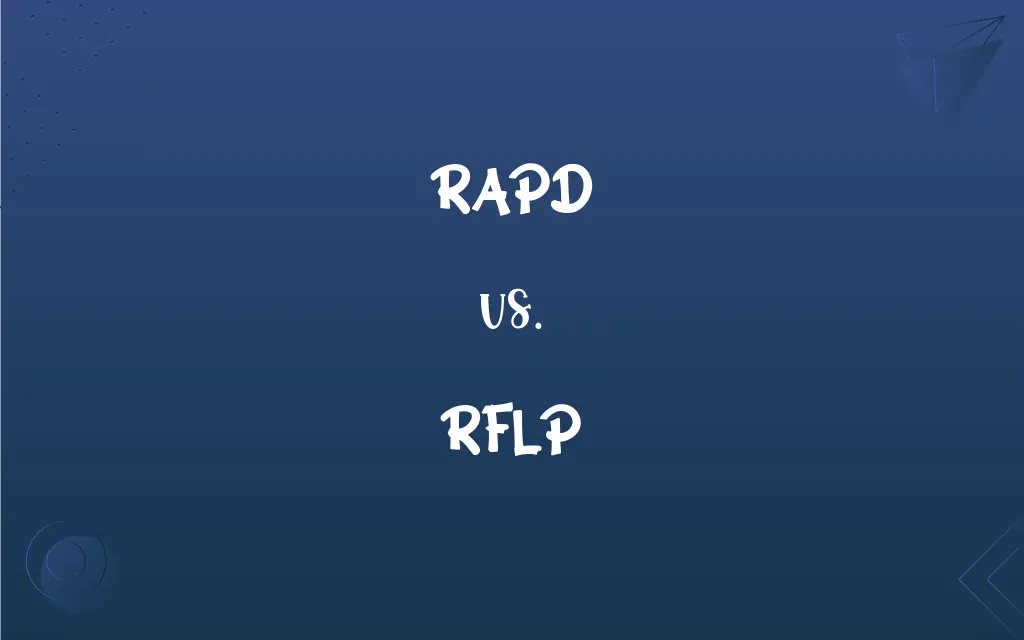RAPD vs. RFLP: What's the Difference?
Edited by Janet White || By Harlon Moss || Updated on October 12, 2023
RAPD (Random Amplified Polymorphic DNA) uses short primers in PCR under low-stringency conditions, while RFLP (Restriction Fragment Length Polymorphism) identifies variations in DNA sequences by enzyme cutting and gel electrophoresis.

Key Differences
RAPD and RFLP, both genetic techniques, harness different methods for exploring polymorphisms within DNA samples. RAPD operates by employing short, random primers in PCR processes under conditions that favor mispriming, consequently creating amplifications throughout various loci. In stark contrast, RFLP discerns variations in DNA sequences by capitalizing on the specificity of restriction enzymes that cleave DNA at particular sites, followed by the segregation of fragments using gel electrophoresis.
The procedural distinction between RAPD and RFLP is notably apparent, as RAPD, utilizing PCR, generates numerous DNA fragments by amplifying varied loci using a single short, random primer under defined conditions. On the other hand, RFLP meticulously examines DNA variations by exploiting restriction enzymes which slice DNA at specific recognition sites, resulting in fragments of differing lengths due to genetic variations.
Regarding applicability and ease, RAPD is lauded for its straightforwardness and minimal prerequisite of sample DNA, enabling efficient analysis without requiring extensive DNA information. Contrastingly, RFLP demands a more intricate knowledge of the DNA sequence to predict the existence and location of restriction sites, often necessitating a more meticulous and deliberate planning and execution of the technique.
In terms of reliability and reproducibility, RAPD, due to its simplicity and lower stringency, might be perceived as somewhat less consistent and potentially susceptible to various experimental variables. Conversely, RFLP, with its reliance on the stringent specificity of restriction enzymes, tends to offer robust reproducibility and is often deemed a stalwart for genetic investigations wherein reliability is paramount.
From a perspective of data interpretation, RAPD commonly yields complex patterns which may be somewhat arduous to decipher without adequate controls. RFLP, whilst demanding in its methodological execution, produces relatively straightforward results, often embodied by clear-cut patterns of DNA fragments, providing a tangible and discernible visualization of genetic variance.
ADVERTISEMENT
Comparison Chart
Basis of Technique
PCR amplification using random primers
Enzyme cutting at specific DNA sequences
Complexity & Ease
Generally simpler and less demanding
Requires knowledge of DNA sequences and is more complex
Reproducibility
May exhibit variability due to lower stringency
Tends to be highly reproducible
DNA Knowledge Requirement
Minimal DNA information is required
Requires DNA sequence knowledge for restriction site ID
Result Interpretation
Can yield complex patterns, potentially challenging
Typically clear, discernible fragment patterns
ADVERTISEMENT
RAPD and RFLP Definitions
RAPD
RAPD allows for the analysis of genetic variations without prior DNA sequence knowledge.
RAPD proved beneficial in the exploration of genetic diversity among the various plant species due to its minimal prerequisites.
RFLP
RFLP employs restriction enzymes to cleave DNA at specific sequences, creating identifiable fragment patterns.
Through RFLP, distinctive DNA fragment lengths were obtained, enabling a detailed examination of genetic divergence.
RAPD
RAPD operates under lower stringency conditions, often resulting in amplification from mispriming.
Through RAPD, multiple fragments were produced due to the occasional mispriming under the utilized conditions.
RFLP
RFLP provides a robust and reproducible method for analyzing genetic variations among samples.
RFLP was chosen for the study due to its dependable nature in revealing genetic distinctions among the specimens.
RAPD
RAPD generates multiple fragments from numerous loci using a single random primer.
The generated fragments from RAPD were utilized to assess genetic diversity among the populations.
RFLP
RFLP identifies genetic variations by analyzing the lengths of DNA fragments after enzyme cutting.
The geneticist used RFLP to differentiate between species based on distinctive fragment patterns after enzyme digestion.
RAPD
RAPD is known for its simplicity and quick execution in genetic studies.
Scientists opted for RAPD to facilitate a quick preliminary survey of the genetic variability among samples.
RFLP
RFLP enables the detection of specific alleles by observing variations in DNA fragment lengths after enzyme digestion.
By scrutinizing fragment lengths in RFLP, researchers deduced the distribution of different alleles in the population.
RAPD
RAPD is a PCR-based technique that utilizes random primers to amplify DNA.
The biologist utilized RAPD to rapidly acquire polymorphic markers for the genetic study.
RFLP
RFLP necessitates knowledge about specific DNA sequences to predict and analyze restriction enzyme cutting sites.
The researchers sequenced the DNA to pinpoint appropriate restriction enzymes for RFLP analysis.
FAQs
What component is visualized in gel electrophoresis in RFLP?
DNA fragments of different lengths, obtained after restriction digestion.
Is RFLP a PCR-based technique?
No, RFLP involves restriction enzyme digestion and gel electrophoresis.
Is RAPD suitable for quick, preliminary genetic studies?
Yes, due to its simplicity and minimal DNA requirements.
How does RFLP identify genetic variations?
By analyzing lengths of DNA fragments after restriction enzyme cutting.
Does RFLP produce variable DNA fragments?
Yes, RFLP creates fragments of varying lengths based on genetic variations.
Can RAPD produce complex amplification patterns?
Yes, RAPD often generates numerous fragments, presenting complex patterns.
What is required to perform an RFLP analysis?
Knowledge of DNA sequences and availability of appropriate restriction enzymes.
Is prior DNA sequencing information essential for RFLP?
Yes, to identify and utilize appropriate restriction enzymes.
Does RFLP require PCR amplification?
No, RFLP involves restriction enzyme digestion without PCR amplification.
What does RAPD stand for?
Random Amplified Polymorphic DNA.
Can RAPD generate polymorphic markers?
Yes, RAPD can amplify numerous loci providing polymorphic markers.
What is the basis of polymorphism detection in RAPD?
Amplification of random loci using a single primer in varied samples.
Can RAPD be used in population genetic studies?
Yes, RAPD is widely utilized in population genetics for its simplicity.
Can RAPD operate without detailed DNA sequence information?
Yes, RAPD requires minimal DNA sequence knowledge.
Does RAPD utilize random primers?
Yes, RAPD uses short, random primers for amplification.
Is RAPD known for high or low stringency PCR?
RAPD is known for utilizing low stringency PCR conditions.
Is RAPD’s repeatability typically high or low?
RAPD can exhibit lower repeatability due to its lower stringency conditions.
What does RFLP stand for?
Restriction Fragment Length Polymorphism.
Is RFLP reliable and reproducible?
Generally, yes, due to the specificity of restriction enzyme cutting.
How is genetic variation visualized in RFLP?
Through differing DNA fragment lengths on a gel after enzyme digestion.
About Author
Written by
Harlon MossHarlon is a seasoned quality moderator and accomplished content writer for Difference Wiki. An alumnus of the prestigious University of California, he earned his degree in Computer Science. Leveraging his academic background, Harlon brings a meticulous and informed perspective to his work, ensuring content accuracy and excellence.
Edited by
Janet WhiteJanet White has been an esteemed writer and blogger for Difference Wiki. Holding a Master's degree in Science and Medical Journalism from the prestigious Boston University, she has consistently demonstrated her expertise and passion for her field. When she's not immersed in her work, Janet relishes her time exercising, delving into a good book, and cherishing moments with friends and family.































































